Global Market Entry Strategies: A Study on Sainsbury's Retail Sector
VerifiedAdded on 2021/02/22
|12
|3590
|53
Report
AI Summary
This report examines the benefits and drawbacks of globalization for businesses, focusing on Sainsbury's as a case study within the retail sector. The research explores the concept of globalization, its impact on business operations, and the strategies employed by companies to enter and sustain themselves in the global market. The report identifies the advantages such as technological advancements, access to larger customer bases, and increased employment opportunities, while also highlighting the challenges like language barriers, cultural differences, and online service issues. The methodology includes a qualitative approach with inductive reasoning, interpretivism for data interpretation, and thematic data analysis. The study uses a questionnaire-based survey of 20 managers at Sainsbury's to gather primary data, alongside secondary data from academic sources. Ethical considerations are addressed through participant consent. The findings are presented to provide recommendations for Sainsbury's to optimize its global market strategies.
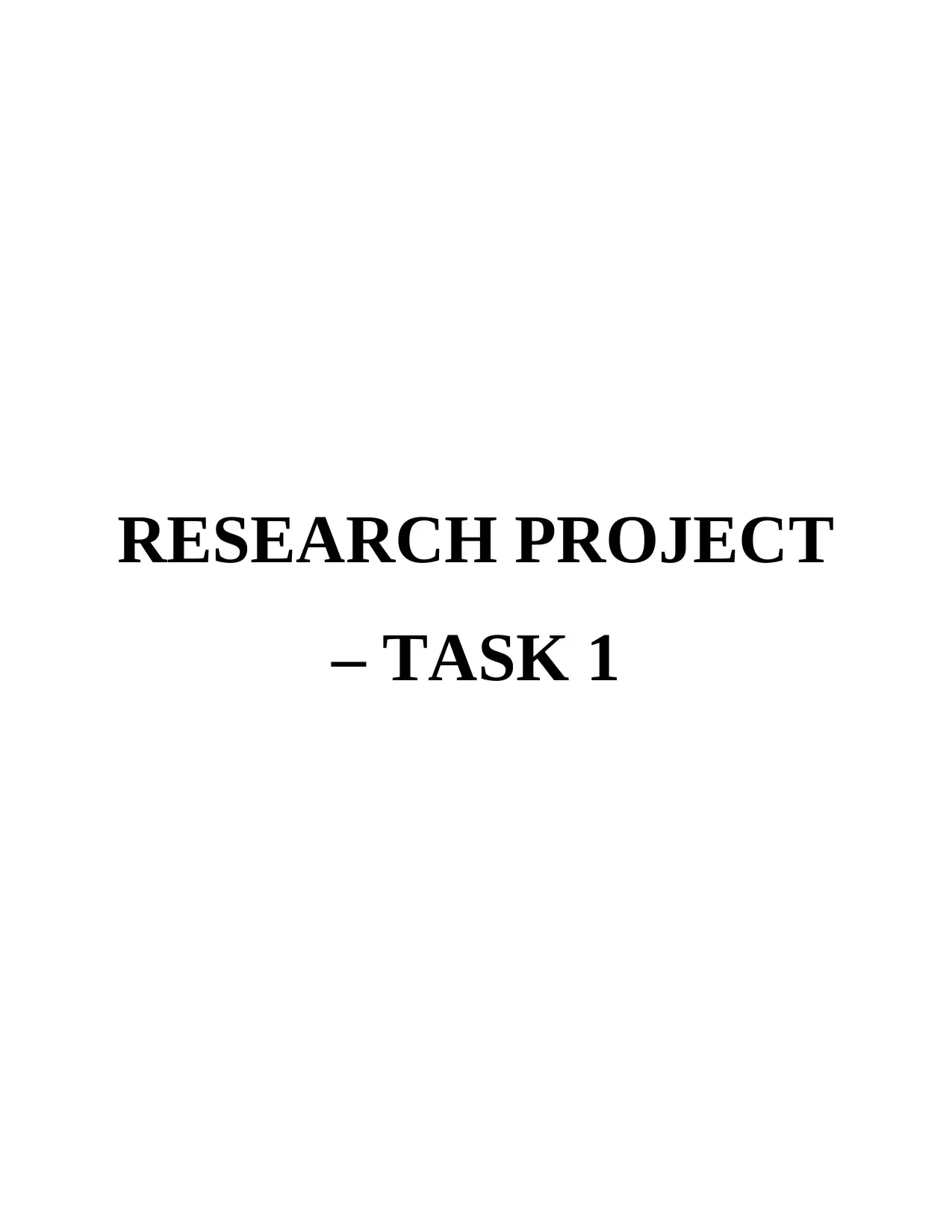
RESEARCH PROJECT
– TASK 1
– TASK 1
Paraphrase This Document
Need a fresh take? Get an instant paraphrase of this document with our AI Paraphraser
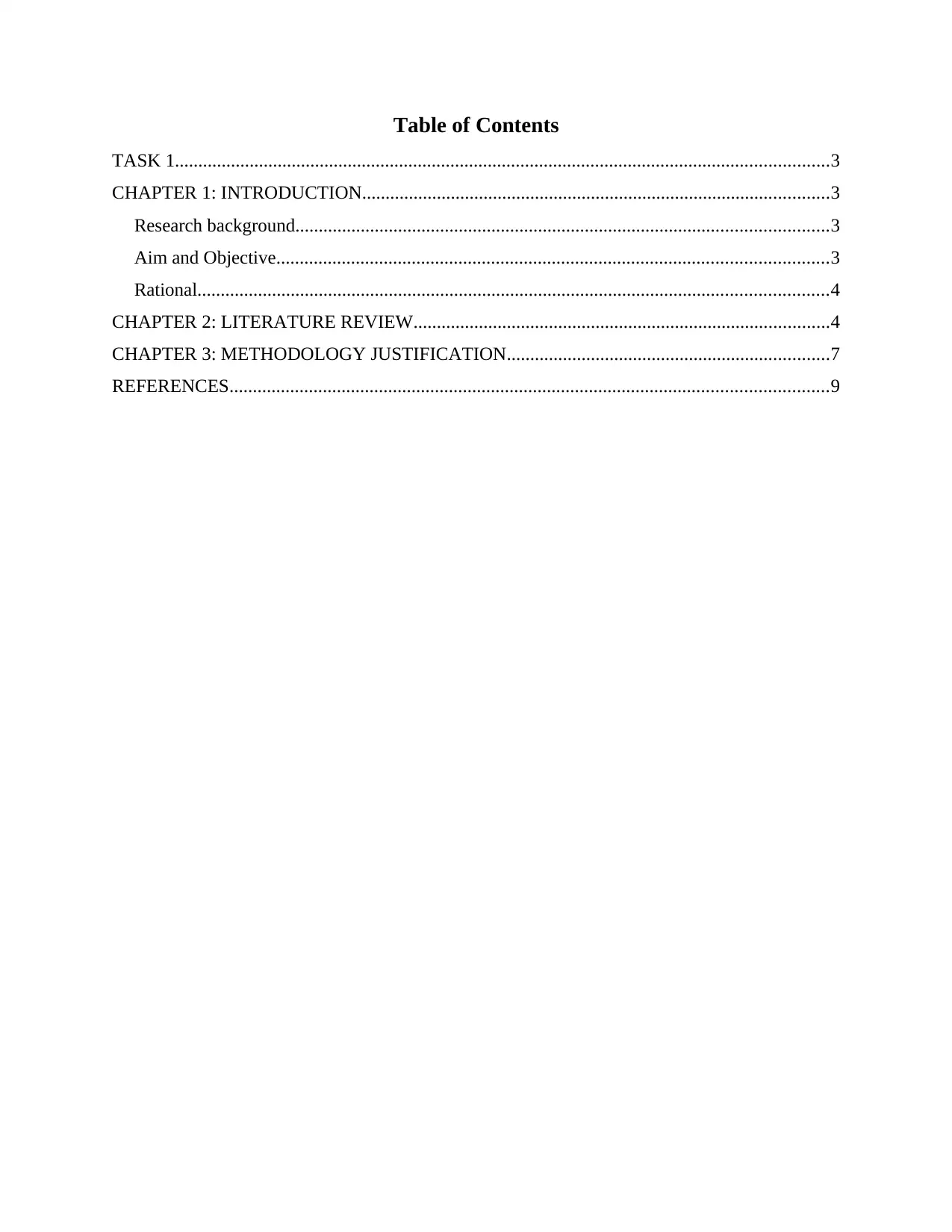
Table of Contents
TASK 1............................................................................................................................................3
CHAPTER 1: INTRODUCTION....................................................................................................3
Research background..................................................................................................................3
Aim and Objective......................................................................................................................3
Rational.......................................................................................................................................4
CHAPTER 2: LITERATURE REVIEW.........................................................................................4
CHAPTER 3: METHODOLOGY JUSTIFICATION.....................................................................7
REFERENCES................................................................................................................................9
TASK 1............................................................................................................................................3
CHAPTER 1: INTRODUCTION....................................................................................................3
Research background..................................................................................................................3
Aim and Objective......................................................................................................................3
Rational.......................................................................................................................................4
CHAPTER 2: LITERATURE REVIEW.........................................................................................4
CHAPTER 3: METHODOLOGY JUSTIFICATION.....................................................................7
REFERENCES................................................................................................................................9
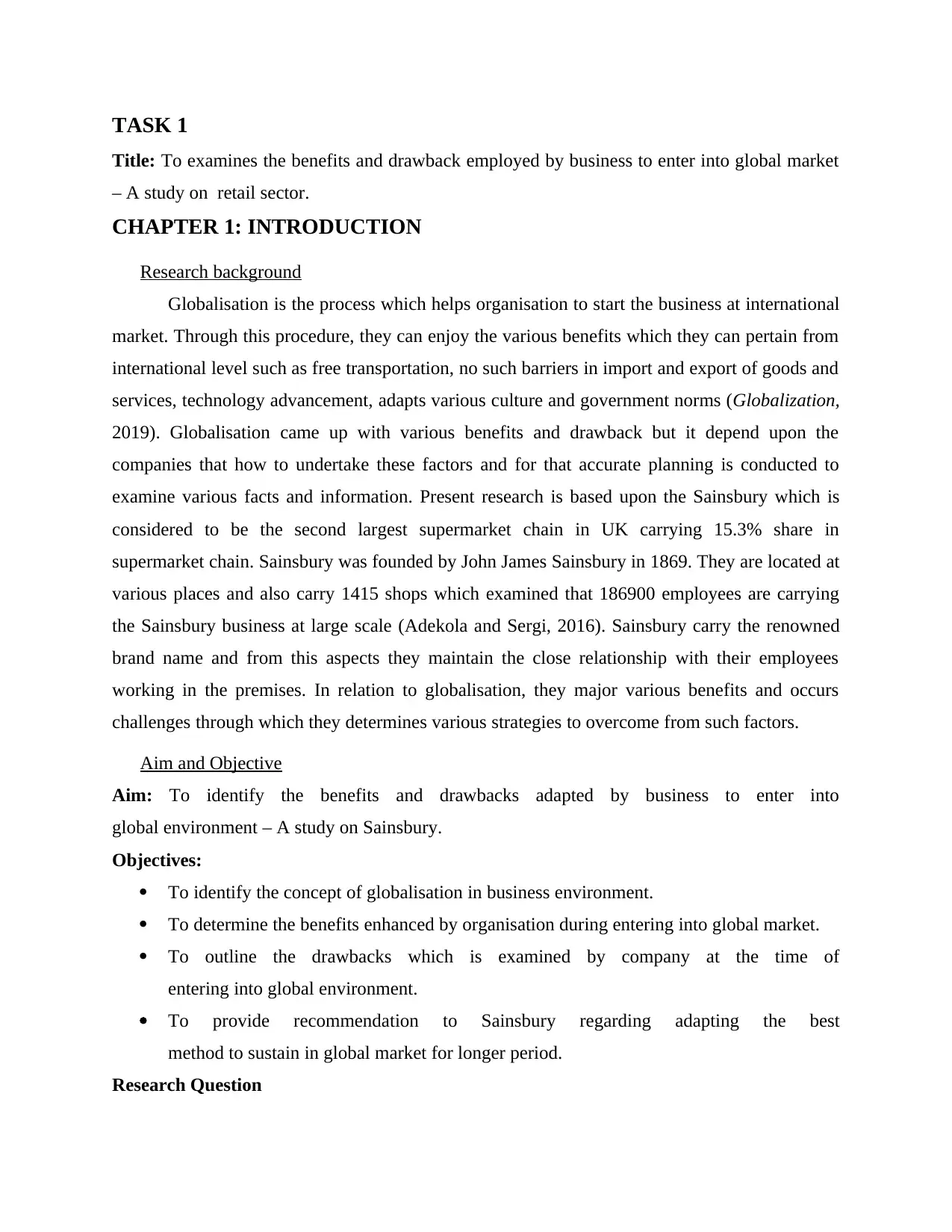
TASK 1
Title: To examines the benefits and drawback employed by business to enter into global market
– A study on retail sector.
CHAPTER 1: INTRODUCTION
Research background
Globalisation is the process which helps organisation to start the business at international
market. Through this procedure, they can enjoy the various benefits which they can pertain from
international level such as free transportation, no such barriers in import and export of goods and
services, technology advancement, adapts various culture and government norms (Globalization,
2019). Globalisation came up with various benefits and drawback but it depend upon the
companies that how to undertake these factors and for that accurate planning is conducted to
examine various facts and information. Present research is based upon the Sainsbury which is
considered to be the second largest supermarket chain in UK carrying 15.3% share in
supermarket chain. Sainsbury was founded by John James Sainsbury in 1869. They are located at
various places and also carry 1415 shops which examined that 186900 employees are carrying
the Sainsbury business at large scale (Adekola and Sergi, 2016). Sainsbury carry the renowned
brand name and from this aspects they maintain the close relationship with their employees
working in the premises. In relation to globalisation, they major various benefits and occurs
challenges through which they determines various strategies to overcome from such factors.
Aim and Objective
Aim: To identify the benefits and drawbacks adapted by business to enter into
global environment – A study on Sainsbury.
Objectives:
To identify the concept of globalisation in business environment.
To determine the benefits enhanced by organisation during entering into global market.
To outline the drawbacks which is examined by company at the time of
entering into global environment.
To provide recommendation to Sainsbury regarding adapting the best
method to sustain in global market for longer period.
Research Question
Title: To examines the benefits and drawback employed by business to enter into global market
– A study on retail sector.
CHAPTER 1: INTRODUCTION
Research background
Globalisation is the process which helps organisation to start the business at international
market. Through this procedure, they can enjoy the various benefits which they can pertain from
international level such as free transportation, no such barriers in import and export of goods and
services, technology advancement, adapts various culture and government norms (Globalization,
2019). Globalisation came up with various benefits and drawback but it depend upon the
companies that how to undertake these factors and for that accurate planning is conducted to
examine various facts and information. Present research is based upon the Sainsbury which is
considered to be the second largest supermarket chain in UK carrying 15.3% share in
supermarket chain. Sainsbury was founded by John James Sainsbury in 1869. They are located at
various places and also carry 1415 shops which examined that 186900 employees are carrying
the Sainsbury business at large scale (Adekola and Sergi, 2016). Sainsbury carry the renowned
brand name and from this aspects they maintain the close relationship with their employees
working in the premises. In relation to globalisation, they major various benefits and occurs
challenges through which they determines various strategies to overcome from such factors.
Aim and Objective
Aim: To identify the benefits and drawbacks adapted by business to enter into
global environment – A study on Sainsbury.
Objectives:
To identify the concept of globalisation in business environment.
To determine the benefits enhanced by organisation during entering into global market.
To outline the drawbacks which is examined by company at the time of
entering into global environment.
To provide recommendation to Sainsbury regarding adapting the best
method to sustain in global market for longer period.
Research Question
⊘ This is a preview!⊘
Do you want full access?
Subscribe today to unlock all pages.

Trusted by 1+ million students worldwide
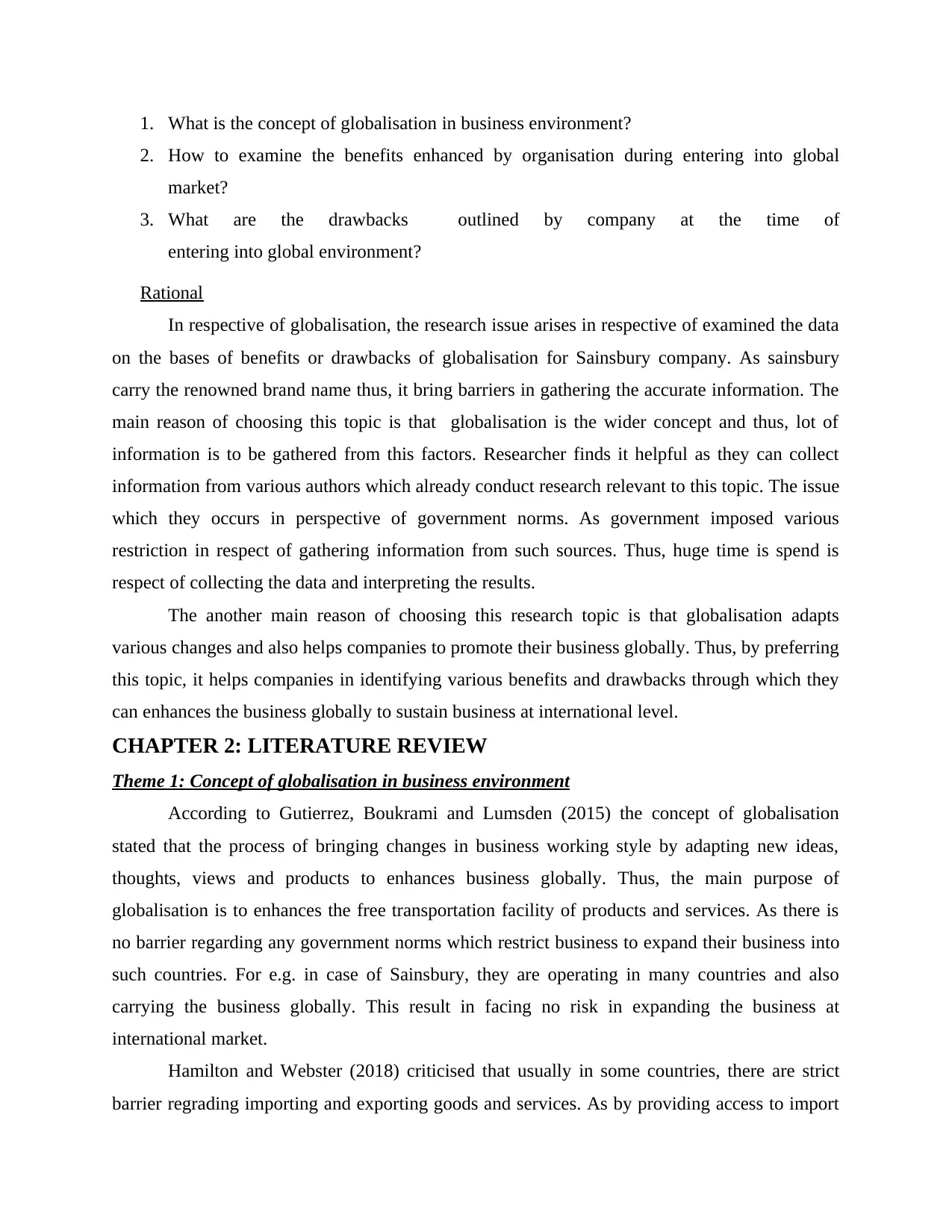
1. What is the concept of globalisation in business environment?
2. How to examine the benefits enhanced by organisation during entering into global
market?
3. What are the drawbacks outlined by company at the time of
entering into global environment?
Rational
In respective of globalisation, the research issue arises in respective of examined the data
on the bases of benefits or drawbacks of globalisation for Sainsbury company. As sainsbury
carry the renowned brand name thus, it bring barriers in gathering the accurate information. The
main reason of choosing this topic is that globalisation is the wider concept and thus, lot of
information is to be gathered from this factors. Researcher finds it helpful as they can collect
information from various authors which already conduct research relevant to this topic. The issue
which they occurs in perspective of government norms. As government imposed various
restriction in respect of gathering information from such sources. Thus, huge time is spend is
respect of collecting the data and interpreting the results.
The another main reason of choosing this research topic is that globalisation adapts
various changes and also helps companies to promote their business globally. Thus, by preferring
this topic, it helps companies in identifying various benefits and drawbacks through which they
can enhances the business globally to sustain business at international level.
CHAPTER 2: LITERATURE REVIEW
Theme 1: Concept of globalisation in business environment
According to Gutierrez, Boukrami and Lumsden (2015) the concept of globalisation
stated that the process of bringing changes in business working style by adapting new ideas,
thoughts, views and products to enhances business globally. Thus, the main purpose of
globalisation is to enhances the free transportation facility of products and services. As there is
no barrier regarding any government norms which restrict business to expand their business into
such countries. For e.g. in case of Sainsbury, they are operating in many countries and also
carrying the business globally. This result in facing no risk in expanding the business at
international market.
Hamilton and Webster (2018) criticised that usually in some countries, there are strict
barrier regrading importing and exporting goods and services. As by providing access to import
2. How to examine the benefits enhanced by organisation during entering into global
market?
3. What are the drawbacks outlined by company at the time of
entering into global environment?
Rational
In respective of globalisation, the research issue arises in respective of examined the data
on the bases of benefits or drawbacks of globalisation for Sainsbury company. As sainsbury
carry the renowned brand name thus, it bring barriers in gathering the accurate information. The
main reason of choosing this topic is that globalisation is the wider concept and thus, lot of
information is to be gathered from this factors. Researcher finds it helpful as they can collect
information from various authors which already conduct research relevant to this topic. The issue
which they occurs in perspective of government norms. As government imposed various
restriction in respect of gathering information from such sources. Thus, huge time is spend is
respect of collecting the data and interpreting the results.
The another main reason of choosing this research topic is that globalisation adapts
various changes and also helps companies to promote their business globally. Thus, by preferring
this topic, it helps companies in identifying various benefits and drawbacks through which they
can enhances the business globally to sustain business at international level.
CHAPTER 2: LITERATURE REVIEW
Theme 1: Concept of globalisation in business environment
According to Gutierrez, Boukrami and Lumsden (2015) the concept of globalisation
stated that the process of bringing changes in business working style by adapting new ideas,
thoughts, views and products to enhances business globally. Thus, the main purpose of
globalisation is to enhances the free transportation facility of products and services. As there is
no barrier regarding any government norms which restrict business to expand their business into
such countries. For e.g. in case of Sainsbury, they are operating in many countries and also
carrying the business globally. This result in facing no risk in expanding the business at
international market.
Hamilton and Webster (2018) criticised that usually in some countries, there are strict
barrier regrading importing and exporting goods and services. As by providing access to import
Paraphrase This Document
Need a fresh take? Get an instant paraphrase of this document with our AI Paraphraser
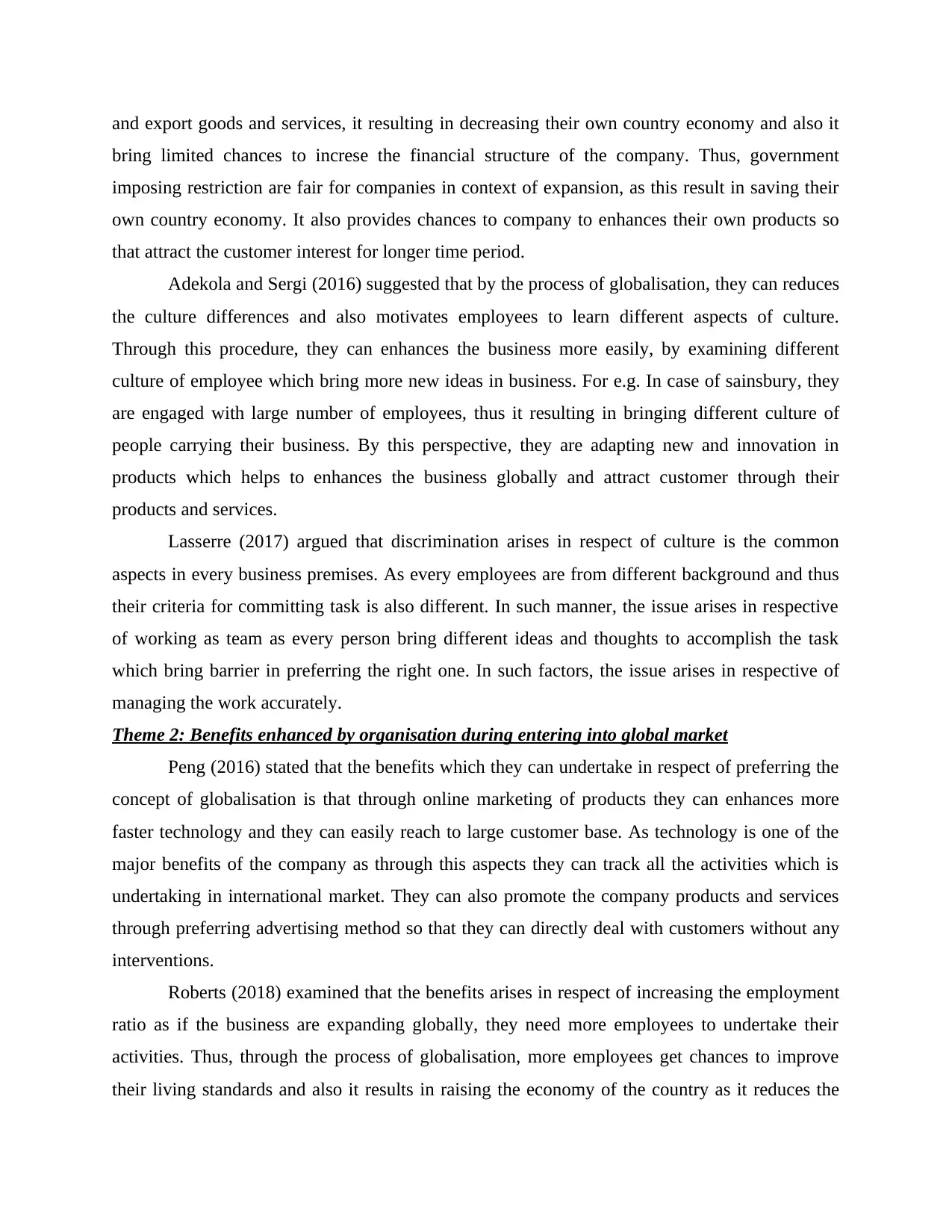
and export goods and services, it resulting in decreasing their own country economy and also it
bring limited chances to increse the financial structure of the company. Thus, government
imposing restriction are fair for companies in context of expansion, as this result in saving their
own country economy. It also provides chances to company to enhances their own products so
that attract the customer interest for longer time period.
Adekola and Sergi (2016) suggested that by the process of globalisation, they can reduces
the culture differences and also motivates employees to learn different aspects of culture.
Through this procedure, they can enhances the business more easily, by examining different
culture of employee which bring more new ideas in business. For e.g. In case of sainsbury, they
are engaged with large number of employees, thus it resulting in bringing different culture of
people carrying their business. By this perspective, they are adapting new and innovation in
products which helps to enhances the business globally and attract customer through their
products and services.
Lasserre (2017) argued that discrimination arises in respect of culture is the common
aspects in every business premises. As every employees are from different background and thus
their criteria for committing task is also different. In such manner, the issue arises in respective
of working as team as every person bring different ideas and thoughts to accomplish the task
which bring barrier in preferring the right one. In such factors, the issue arises in respective of
managing the work accurately.
Theme 2: Benefits enhanced by organisation during entering into global market
Peng (2016) stated that the benefits which they can undertake in respect of preferring the
concept of globalisation is that through online marketing of products they can enhances more
faster technology and they can easily reach to large customer base. As technology is one of the
major benefits of the company as through this aspects they can track all the activities which is
undertaking in international market. They can also promote the company products and services
through preferring advertising method so that they can directly deal with customers without any
interventions.
Roberts (2018) examined that the benefits arises in respect of increasing the employment
ratio as if the business are expanding globally, they need more employees to undertake their
activities. Thus, through the process of globalisation, more employees get chances to improve
their living standards and also it results in raising the economy of the country as it reduces the
bring limited chances to increse the financial structure of the company. Thus, government
imposing restriction are fair for companies in context of expansion, as this result in saving their
own country economy. It also provides chances to company to enhances their own products so
that attract the customer interest for longer time period.
Adekola and Sergi (2016) suggested that by the process of globalisation, they can reduces
the culture differences and also motivates employees to learn different aspects of culture.
Through this procedure, they can enhances the business more easily, by examining different
culture of employee which bring more new ideas in business. For e.g. In case of sainsbury, they
are engaged with large number of employees, thus it resulting in bringing different culture of
people carrying their business. By this perspective, they are adapting new and innovation in
products which helps to enhances the business globally and attract customer through their
products and services.
Lasserre (2017) argued that discrimination arises in respect of culture is the common
aspects in every business premises. As every employees are from different background and thus
their criteria for committing task is also different. In such manner, the issue arises in respective
of working as team as every person bring different ideas and thoughts to accomplish the task
which bring barrier in preferring the right one. In such factors, the issue arises in respective of
managing the work accurately.
Theme 2: Benefits enhanced by organisation during entering into global market
Peng (2016) stated that the benefits which they can undertake in respect of preferring the
concept of globalisation is that through online marketing of products they can enhances more
faster technology and they can easily reach to large customer base. As technology is one of the
major benefits of the company as through this aspects they can track all the activities which is
undertaking in international market. They can also promote the company products and services
through preferring advertising method so that they can directly deal with customers without any
interventions.
Roberts (2018) examined that the benefits arises in respect of increasing the employment
ratio as if the business are expanding globally, they need more employees to undertake their
activities. Thus, through the process of globalisation, more employees get chances to improve
their living standards and also it results in raising the economy of the country as it reduces the
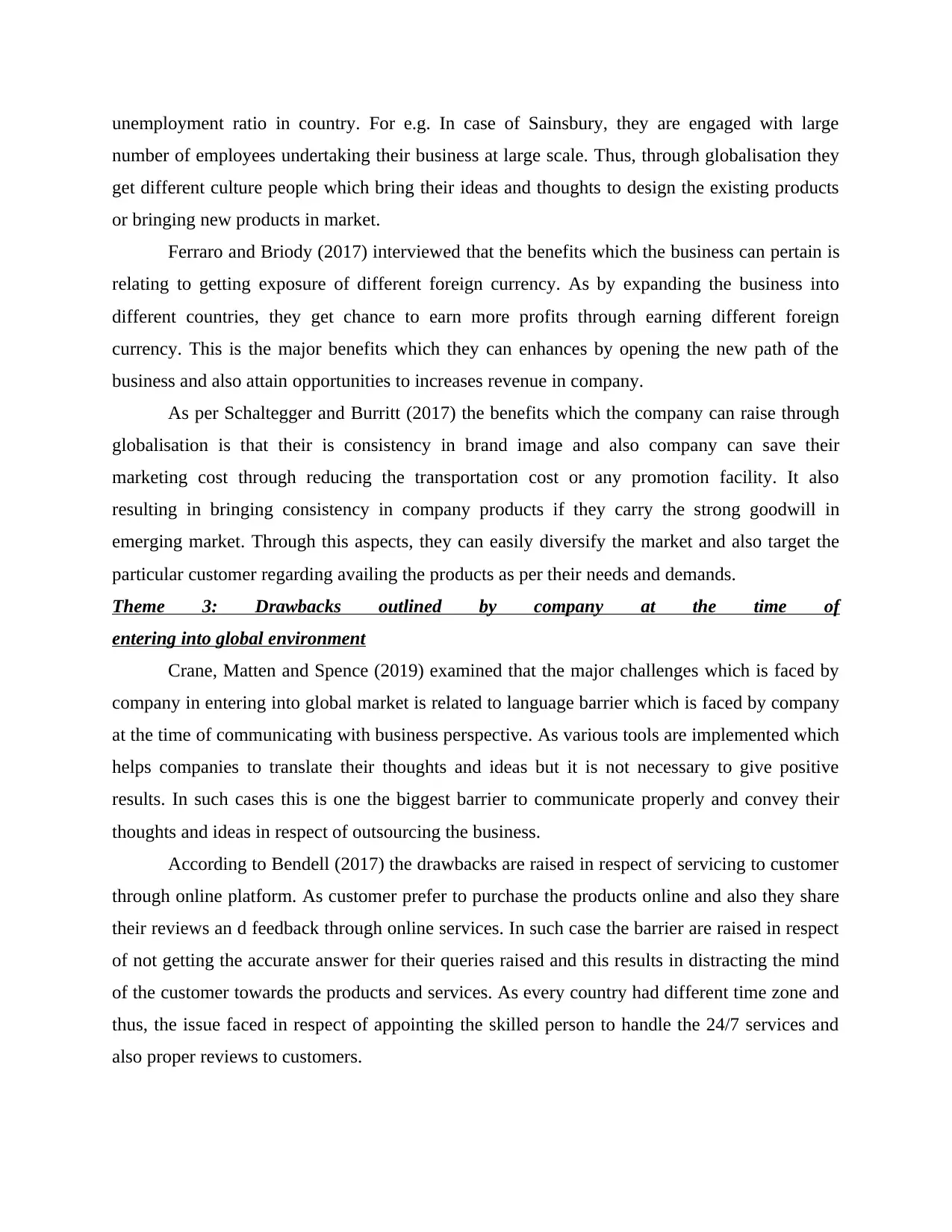
unemployment ratio in country. For e.g. In case of Sainsbury, they are engaged with large
number of employees undertaking their business at large scale. Thus, through globalisation they
get different culture people which bring their ideas and thoughts to design the existing products
or bringing new products in market.
Ferraro and Briody (2017) interviewed that the benefits which the business can pertain is
relating to getting exposure of different foreign currency. As by expanding the business into
different countries, they get chance to earn more profits through earning different foreign
currency. This is the major benefits which they can enhances by opening the new path of the
business and also attain opportunities to increases revenue in company.
As per Schaltegger and Burritt (2017) the benefits which the company can raise through
globalisation is that their is consistency in brand image and also company can save their
marketing cost through reducing the transportation cost or any promotion facility. It also
resulting in bringing consistency in company products if they carry the strong goodwill in
emerging market. Through this aspects, they can easily diversify the market and also target the
particular customer regarding availing the products as per their needs and demands.
Theme 3: Drawbacks outlined by company at the time of
entering into global environment
Crane, Matten and Spence (2019) examined that the major challenges which is faced by
company in entering into global market is related to language barrier which is faced by company
at the time of communicating with business perspective. As various tools are implemented which
helps companies to translate their thoughts and ideas but it is not necessary to give positive
results. In such cases this is one the biggest barrier to communicate properly and convey their
thoughts and ideas in respect of outsourcing the business.
According to Bendell (2017) the drawbacks are raised in respect of servicing to customer
through online platform. As customer prefer to purchase the products online and also they share
their reviews an d feedback through online services. In such case the barrier are raised in respect
of not getting the accurate answer for their queries raised and this results in distracting the mind
of the customer towards the products and services. As every country had different time zone and
thus, the issue faced in respect of appointing the skilled person to handle the 24/7 services and
also proper reviews to customers.
number of employees undertaking their business at large scale. Thus, through globalisation they
get different culture people which bring their ideas and thoughts to design the existing products
or bringing new products in market.
Ferraro and Briody (2017) interviewed that the benefits which the business can pertain is
relating to getting exposure of different foreign currency. As by expanding the business into
different countries, they get chance to earn more profits through earning different foreign
currency. This is the major benefits which they can enhances by opening the new path of the
business and also attain opportunities to increases revenue in company.
As per Schaltegger and Burritt (2017) the benefits which the company can raise through
globalisation is that their is consistency in brand image and also company can save their
marketing cost through reducing the transportation cost or any promotion facility. It also
resulting in bringing consistency in company products if they carry the strong goodwill in
emerging market. Through this aspects, they can easily diversify the market and also target the
particular customer regarding availing the products as per their needs and demands.
Theme 3: Drawbacks outlined by company at the time of
entering into global environment
Crane, Matten and Spence (2019) examined that the major challenges which is faced by
company in entering into global market is related to language barrier which is faced by company
at the time of communicating with business perspective. As various tools are implemented which
helps companies to translate their thoughts and ideas but it is not necessary to give positive
results. In such cases this is one the biggest barrier to communicate properly and convey their
thoughts and ideas in respect of outsourcing the business.
According to Bendell (2017) the drawbacks are raised in respect of servicing to customer
through online platform. As customer prefer to purchase the products online and also they share
their reviews an d feedback through online services. In such case the barrier are raised in respect
of not getting the accurate answer for their queries raised and this results in distracting the mind
of the customer towards the products and services. As every country had different time zone and
thus, the issue faced in respect of appointing the skilled person to handle the 24/7 services and
also proper reviews to customers.
⊘ This is a preview!⊘
Do you want full access?
Subscribe today to unlock all pages.

Trusted by 1+ million students worldwide
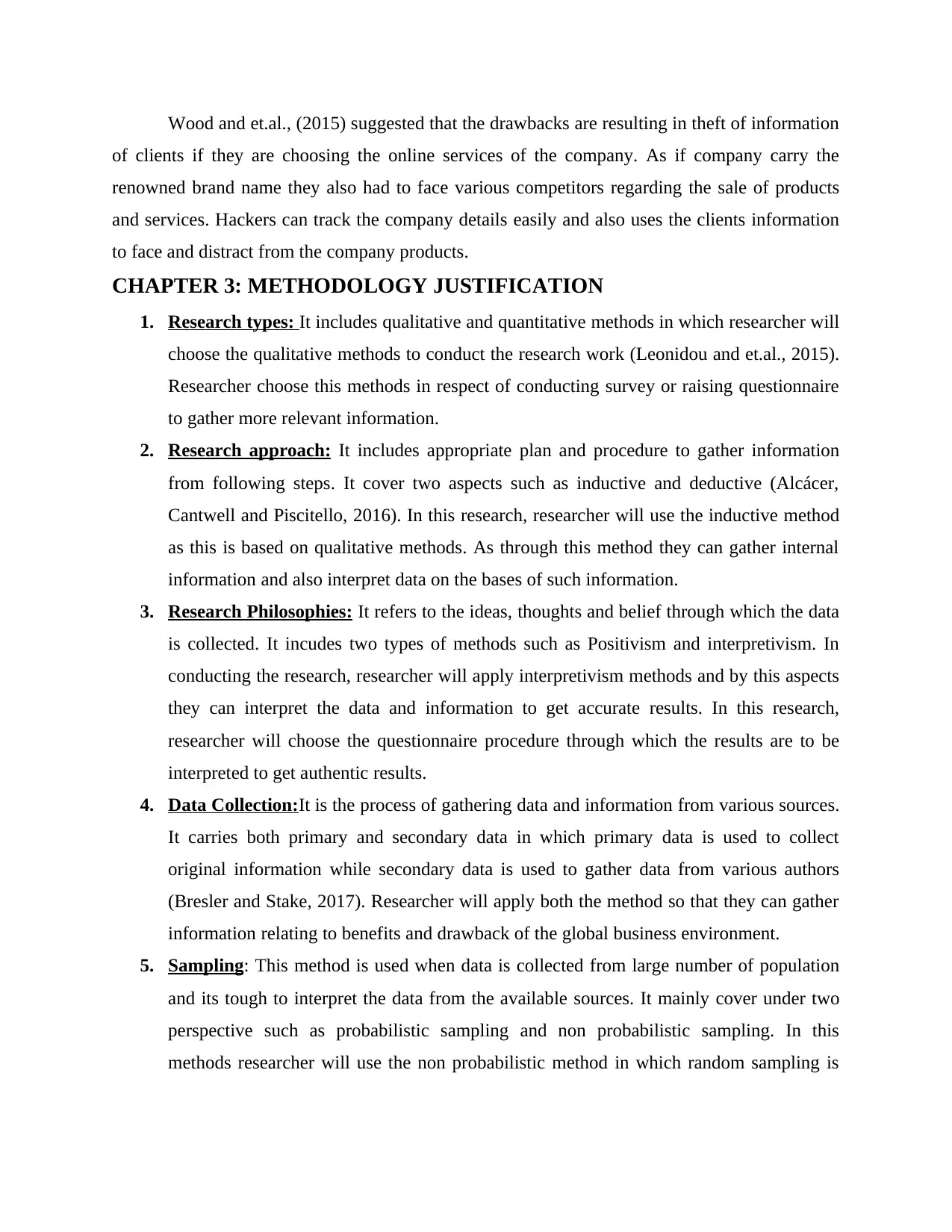
Wood and et.al., (2015) suggested that the drawbacks are resulting in theft of information
of clients if they are choosing the online services of the company. As if company carry the
renowned brand name they also had to face various competitors regarding the sale of products
and services. Hackers can track the company details easily and also uses the clients information
to face and distract from the company products.
CHAPTER 3: METHODOLOGY JUSTIFICATION
1. Research types: It includes qualitative and quantitative methods in which researcher will
choose the qualitative methods to conduct the research work (Leonidou and et.al., 2015).
Researcher choose this methods in respect of conducting survey or raising questionnaire
to gather more relevant information.
2. Research approach: It includes appropriate plan and procedure to gather information
from following steps. It cover two aspects such as inductive and deductive (Alcácer,
Cantwell and Piscitello, 2016). In this research, researcher will use the inductive method
as this is based on qualitative methods. As through this method they can gather internal
information and also interpret data on the bases of such information.
3. Research Philosophies: It refers to the ideas, thoughts and belief through which the data
is collected. It incudes two types of methods such as Positivism and interpretivism. In
conducting the research, researcher will apply interpretivism methods and by this aspects
they can interpret the data and information to get accurate results. In this research,
researcher will choose the questionnaire procedure through which the results are to be
interpreted to get authentic results.
4. Data Collection:It is the process of gathering data and information from various sources.
It carries both primary and secondary data in which primary data is used to collect
original information while secondary data is used to gather data from various authors
(Bresler and Stake, 2017). Researcher will apply both the method so that they can gather
information relating to benefits and drawback of the global business environment.
5. Sampling: This method is used when data is collected from large number of population
and its tough to interpret the data from the available sources. It mainly cover under two
perspective such as probabilistic sampling and non probabilistic sampling. In this
methods researcher will use the non probabilistic method in which random sampling is
of clients if they are choosing the online services of the company. As if company carry the
renowned brand name they also had to face various competitors regarding the sale of products
and services. Hackers can track the company details easily and also uses the clients information
to face and distract from the company products.
CHAPTER 3: METHODOLOGY JUSTIFICATION
1. Research types: It includes qualitative and quantitative methods in which researcher will
choose the qualitative methods to conduct the research work (Leonidou and et.al., 2015).
Researcher choose this methods in respect of conducting survey or raising questionnaire
to gather more relevant information.
2. Research approach: It includes appropriate plan and procedure to gather information
from following steps. It cover two aspects such as inductive and deductive (Alcácer,
Cantwell and Piscitello, 2016). In this research, researcher will use the inductive method
as this is based on qualitative methods. As through this method they can gather internal
information and also interpret data on the bases of such information.
3. Research Philosophies: It refers to the ideas, thoughts and belief through which the data
is collected. It incudes two types of methods such as Positivism and interpretivism. In
conducting the research, researcher will apply interpretivism methods and by this aspects
they can interpret the data and information to get accurate results. In this research,
researcher will choose the questionnaire procedure through which the results are to be
interpreted to get authentic results.
4. Data Collection:It is the process of gathering data and information from various sources.
It carries both primary and secondary data in which primary data is used to collect
original information while secondary data is used to gather data from various authors
(Bresler and Stake, 2017). Researcher will apply both the method so that they can gather
information relating to benefits and drawback of the global business environment.
5. Sampling: This method is used when data is collected from large number of population
and its tough to interpret the data from the available sources. It mainly cover under two
perspective such as probabilistic sampling and non probabilistic sampling. In this
methods researcher will use the non probabilistic method in which random sampling is
Paraphrase This Document
Need a fresh take? Get an instant paraphrase of this document with our AI Paraphraser
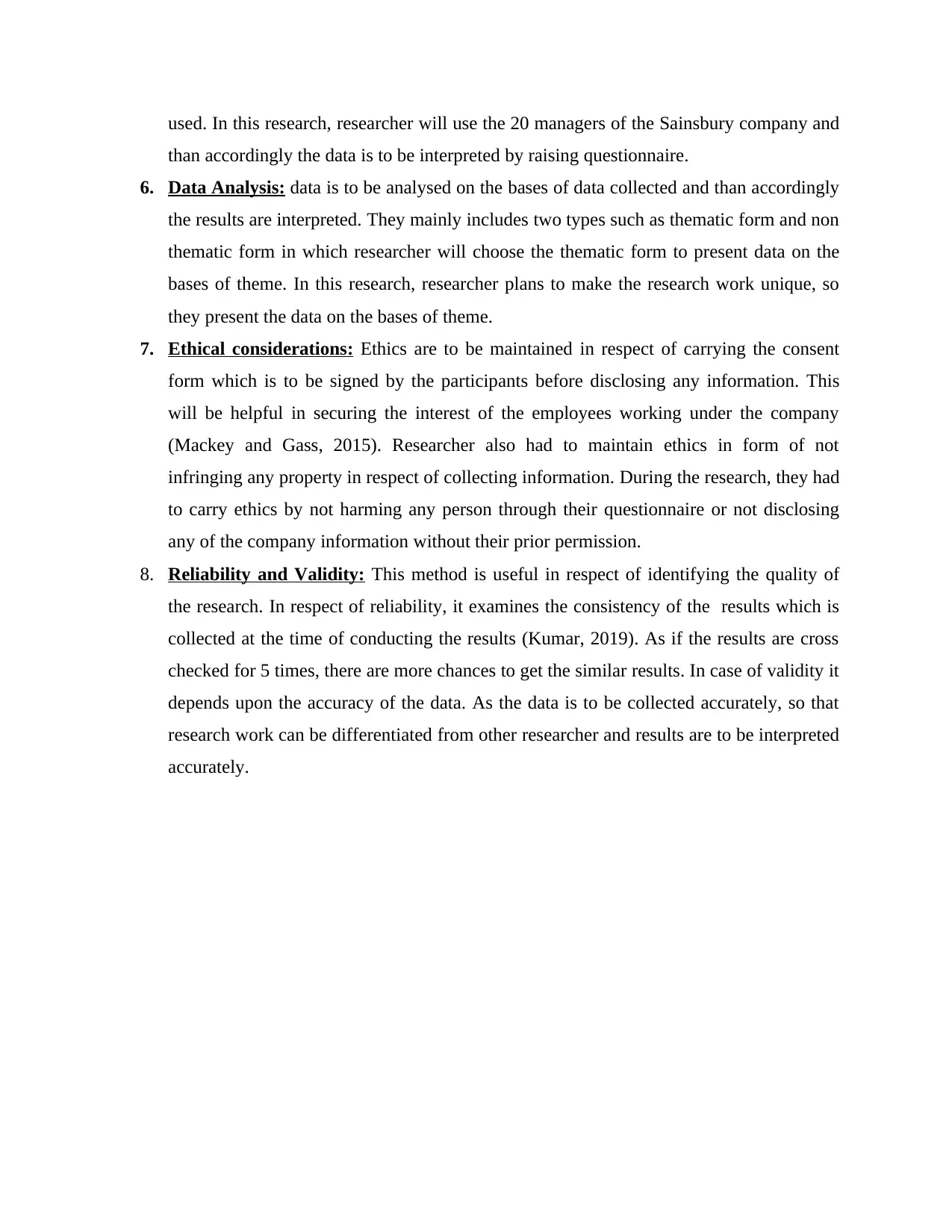
used. In this research, researcher will use the 20 managers of the Sainsbury company and
than accordingly the data is to be interpreted by raising questionnaire.
6. Data Analysis: data is to be analysed on the bases of data collected and than accordingly
the results are interpreted. They mainly includes two types such as thematic form and non
thematic form in which researcher will choose the thematic form to present data on the
bases of theme. In this research, researcher plans to make the research work unique, so
they present the data on the bases of theme.
7. Ethical considerations: Ethics are to be maintained in respect of carrying the consent
form which is to be signed by the participants before disclosing any information. This
will be helpful in securing the interest of the employees working under the company
(Mackey and Gass, 2015). Researcher also had to maintain ethics in form of not
infringing any property in respect of collecting information. During the research, they had
to carry ethics by not harming any person through their questionnaire or not disclosing
any of the company information without their prior permission.
8. Reliability and Validity: This method is useful in respect of identifying the quality of
the research. In respect of reliability, it examines the consistency of the results which is
collected at the time of conducting the results (Kumar, 2019). As if the results are cross
checked for 5 times, there are more chances to get the similar results. In case of validity it
depends upon the accuracy of the data. As the data is to be collected accurately, so that
research work can be differentiated from other researcher and results are to be interpreted
accurately.
than accordingly the data is to be interpreted by raising questionnaire.
6. Data Analysis: data is to be analysed on the bases of data collected and than accordingly
the results are interpreted. They mainly includes two types such as thematic form and non
thematic form in which researcher will choose the thematic form to present data on the
bases of theme. In this research, researcher plans to make the research work unique, so
they present the data on the bases of theme.
7. Ethical considerations: Ethics are to be maintained in respect of carrying the consent
form which is to be signed by the participants before disclosing any information. This
will be helpful in securing the interest of the employees working under the company
(Mackey and Gass, 2015). Researcher also had to maintain ethics in form of not
infringing any property in respect of collecting information. During the research, they had
to carry ethics by not harming any person through their questionnaire or not disclosing
any of the company information without their prior permission.
8. Reliability and Validity: This method is useful in respect of identifying the quality of
the research. In respect of reliability, it examines the consistency of the results which is
collected at the time of conducting the results (Kumar, 2019). As if the results are cross
checked for 5 times, there are more chances to get the similar results. In case of validity it
depends upon the accuracy of the data. As the data is to be collected accurately, so that
research work can be differentiated from other researcher and results are to be interpreted
accurately.
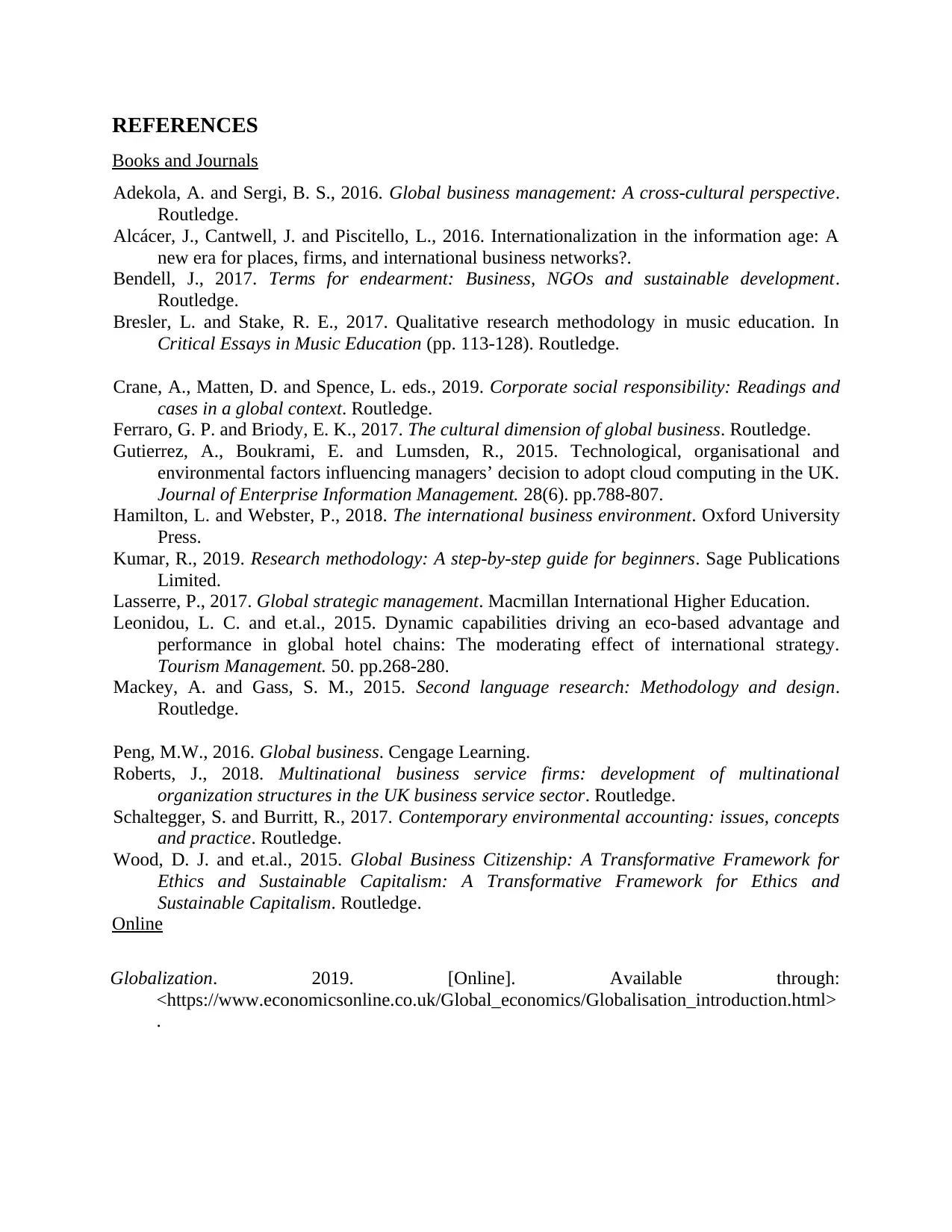
REFERENCES
Books and Journals
Adekola, A. and Sergi, B. S., 2016. Global business management: A cross-cultural perspective.
Routledge.
Alcácer, J., Cantwell, J. and Piscitello, L., 2016. Internationalization in the information age: A
new era for places, firms, and international business networks?.
Bendell, J., 2017. Terms for endearment: Business, NGOs and sustainable development.
Routledge.
Bresler, L. and Stake, R. E., 2017. Qualitative research methodology in music education. In
Critical Essays in Music Education (pp. 113-128). Routledge.
Crane, A., Matten, D. and Spence, L. eds., 2019. Corporate social responsibility: Readings and
cases in a global context. Routledge.
Ferraro, G. P. and Briody, E. K., 2017. The cultural dimension of global business. Routledge.
Gutierrez, A., Boukrami, E. and Lumsden, R., 2015. Technological, organisational and
environmental factors influencing managers’ decision to adopt cloud computing in the UK.
Journal of Enterprise Information Management. 28(6). pp.788-807.
Hamilton, L. and Webster, P., 2018. The international business environment. Oxford University
Press.
Kumar, R., 2019. Research methodology: A step-by-step guide for beginners. Sage Publications
Limited.
Lasserre, P., 2017. Global strategic management. Macmillan International Higher Education.
Leonidou, L. C. and et.al., 2015. Dynamic capabilities driving an eco-based advantage and
performance in global hotel chains: The moderating effect of international strategy.
Tourism Management. 50. pp.268-280.
Mackey, A. and Gass, S. M., 2015. Second language research: Methodology and design.
Routledge.
Peng, M.W., 2016. Global business. Cengage Learning.
Roberts, J., 2018. Multinational business service firms: development of multinational
organization structures in the UK business service sector. Routledge.
Schaltegger, S. and Burritt, R., 2017. Contemporary environmental accounting: issues, concepts
and practice. Routledge.
Wood, D. J. and et.al., 2015. Global Business Citizenship: A Transformative Framework for
Ethics and Sustainable Capitalism: A Transformative Framework for Ethics and
Sustainable Capitalism. Routledge.
Online
Globalization. 2019. [Online]. Available through:
<https://www.economicsonline.co.uk/Global_economics/Globalisation_introduction.html>
.
Books and Journals
Adekola, A. and Sergi, B. S., 2016. Global business management: A cross-cultural perspective.
Routledge.
Alcácer, J., Cantwell, J. and Piscitello, L., 2016. Internationalization in the information age: A
new era for places, firms, and international business networks?.
Bendell, J., 2017. Terms for endearment: Business, NGOs and sustainable development.
Routledge.
Bresler, L. and Stake, R. E., 2017. Qualitative research methodology in music education. In
Critical Essays in Music Education (pp. 113-128). Routledge.
Crane, A., Matten, D. and Spence, L. eds., 2019. Corporate social responsibility: Readings and
cases in a global context. Routledge.
Ferraro, G. P. and Briody, E. K., 2017. The cultural dimension of global business. Routledge.
Gutierrez, A., Boukrami, E. and Lumsden, R., 2015. Technological, organisational and
environmental factors influencing managers’ decision to adopt cloud computing in the UK.
Journal of Enterprise Information Management. 28(6). pp.788-807.
Hamilton, L. and Webster, P., 2018. The international business environment. Oxford University
Press.
Kumar, R., 2019. Research methodology: A step-by-step guide for beginners. Sage Publications
Limited.
Lasserre, P., 2017. Global strategic management. Macmillan International Higher Education.
Leonidou, L. C. and et.al., 2015. Dynamic capabilities driving an eco-based advantage and
performance in global hotel chains: The moderating effect of international strategy.
Tourism Management. 50. pp.268-280.
Mackey, A. and Gass, S. M., 2015. Second language research: Methodology and design.
Routledge.
Peng, M.W., 2016. Global business. Cengage Learning.
Roberts, J., 2018. Multinational business service firms: development of multinational
organization structures in the UK business service sector. Routledge.
Schaltegger, S. and Burritt, R., 2017. Contemporary environmental accounting: issues, concepts
and practice. Routledge.
Wood, D. J. and et.al., 2015. Global Business Citizenship: A Transformative Framework for
Ethics and Sustainable Capitalism: A Transformative Framework for Ethics and
Sustainable Capitalism. Routledge.
Online
Globalization. 2019. [Online]. Available through:
<https://www.economicsonline.co.uk/Global_economics/Globalisation_introduction.html>
.
⊘ This is a preview!⊘
Do you want full access?
Subscribe today to unlock all pages.

Trusted by 1+ million students worldwide
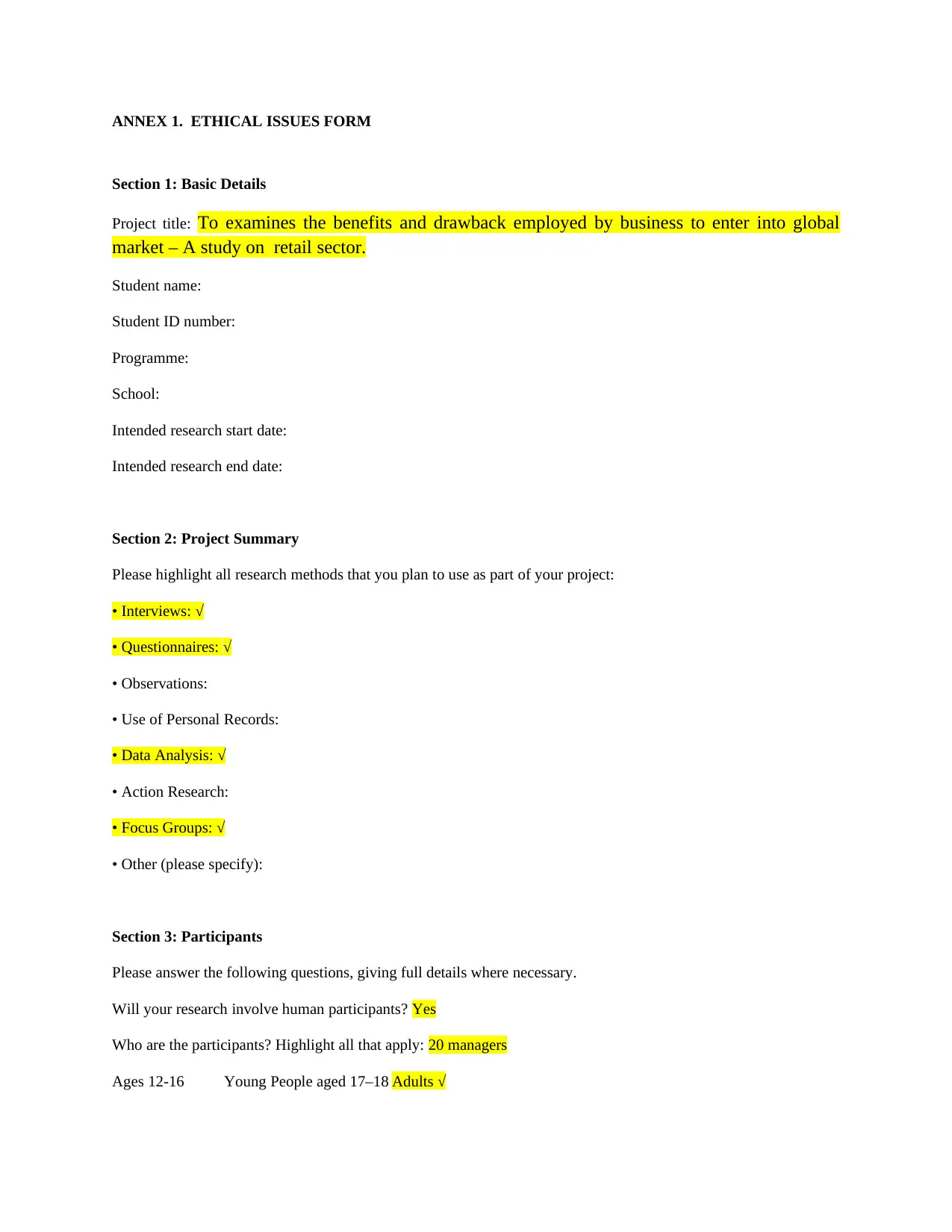
ANNEX 1. ETHICAL ISSUES FORM
Section 1: Basic Details
Project title: To examines the benefits and drawback employed by business to enter into global
market – A study on retail sector.
Student name:
Student ID number:
Programme:
School:
Intended research start date:
Intended research end date:
Section 2: Project Summary
Please highlight all research methods that you plan to use as part of your project:
• Interviews: √
• Questionnaires: √
• Observations:
• Use of Personal Records:
• Data Analysis: √
• Action Research:
• Focus Groups: √
• Other (please specify):
Section 3: Participants
Please answer the following questions, giving full details where necessary.
Will your research involve human participants? Yes
Who are the participants? Highlight all that apply: 20 managers
Ages 12-16 Young People aged 17–18 Adults √
Section 1: Basic Details
Project title: To examines the benefits and drawback employed by business to enter into global
market – A study on retail sector.
Student name:
Student ID number:
Programme:
School:
Intended research start date:
Intended research end date:
Section 2: Project Summary
Please highlight all research methods that you plan to use as part of your project:
• Interviews: √
• Questionnaires: √
• Observations:
• Use of Personal Records:
• Data Analysis: √
• Action Research:
• Focus Groups: √
• Other (please specify):
Section 3: Participants
Please answer the following questions, giving full details where necessary.
Will your research involve human participants? Yes
Who are the participants? Highlight all that apply: 20 managers
Ages 12-16 Young People aged 17–18 Adults √
Paraphrase This Document
Need a fresh take? Get an instant paraphrase of this document with our AI Paraphraser
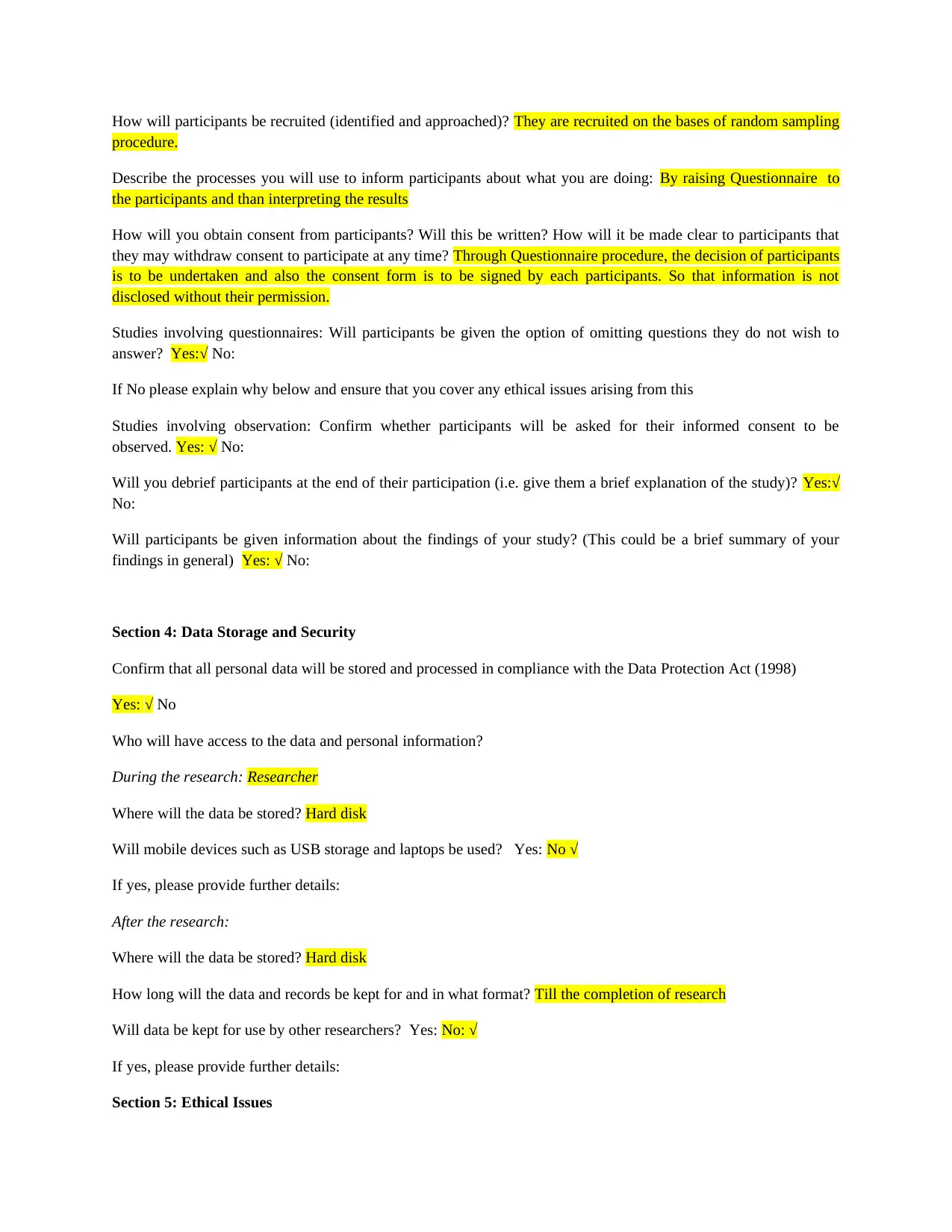
How will participants be recruited (identified and approached)? They are recruited on the bases of random sampling
procedure.
Describe the processes you will use to inform participants about what you are doing: By raising Questionnaire to
the participants and than interpreting the results
How will you obtain consent from participants? Will this be written? How will it be made clear to participants that
they may withdraw consent to participate at any time? Through Questionnaire procedure, the decision of participants
is to be undertaken and also the consent form is to be signed by each participants. So that information is not
disclosed without their permission.
Studies involving questionnaires: Will participants be given the option of omitting questions they do not wish to
answer? Yes:√ No:
If No please explain why below and ensure that you cover any ethical issues arising from this
Studies involving observation: Confirm whether participants will be asked for their informed consent to be
observed. Yes: √ No:
Will you debrief participants at the end of their participation (i.e. give them a brief explanation of the study)? Yes:√
No:
Will participants be given information about the findings of your study? (This could be a brief summary of your
findings in general) Yes: √ No:
Section 4: Data Storage and Security
Confirm that all personal data will be stored and processed in compliance with the Data Protection Act (1998)
Yes: √ No
Who will have access to the data and personal information?
During the research: Researcher
Where will the data be stored? Hard disk
Will mobile devices such as USB storage and laptops be used? Yes: No √
If yes, please provide further details:
After the research:
Where will the data be stored? Hard disk
How long will the data and records be kept for and in what format? Till the completion of research
Will data be kept for use by other researchers? Yes: No: √
If yes, please provide further details:
Section 5: Ethical Issues
procedure.
Describe the processes you will use to inform participants about what you are doing: By raising Questionnaire to
the participants and than interpreting the results
How will you obtain consent from participants? Will this be written? How will it be made clear to participants that
they may withdraw consent to participate at any time? Through Questionnaire procedure, the decision of participants
is to be undertaken and also the consent form is to be signed by each participants. So that information is not
disclosed without their permission.
Studies involving questionnaires: Will participants be given the option of omitting questions they do not wish to
answer? Yes:√ No:
If No please explain why below and ensure that you cover any ethical issues arising from this
Studies involving observation: Confirm whether participants will be asked for their informed consent to be
observed. Yes: √ No:
Will you debrief participants at the end of their participation (i.e. give them a brief explanation of the study)? Yes:√
No:
Will participants be given information about the findings of your study? (This could be a brief summary of your
findings in general) Yes: √ No:
Section 4: Data Storage and Security
Confirm that all personal data will be stored and processed in compliance with the Data Protection Act (1998)
Yes: √ No
Who will have access to the data and personal information?
During the research: Researcher
Where will the data be stored? Hard disk
Will mobile devices such as USB storage and laptops be used? Yes: No √
If yes, please provide further details:
After the research:
Where will the data be stored? Hard disk
How long will the data and records be kept for and in what format? Till the completion of research
Will data be kept for use by other researchers? Yes: No: √
If yes, please provide further details:
Section 5: Ethical Issues
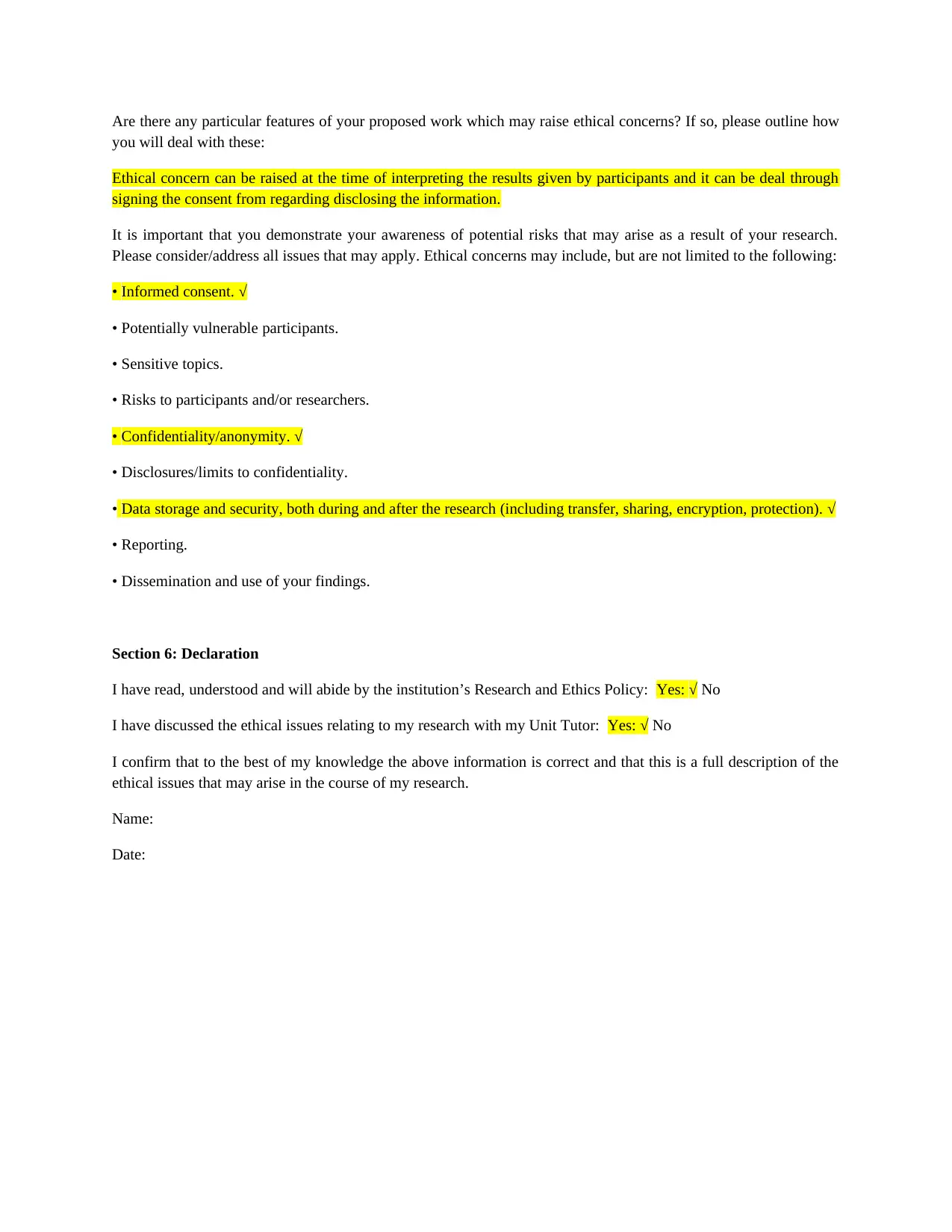
Are there any particular features of your proposed work which may raise ethical concerns? If so, please outline how
you will deal with these:
Ethical concern can be raised at the time of interpreting the results given by participants and it can be deal through
signing the consent from regarding disclosing the information.
It is important that you demonstrate your awareness of potential risks that may arise as a result of your research.
Please consider/address all issues that may apply. Ethical concerns may include, but are not limited to the following:
• Informed consent. √
• Potentially vulnerable participants.
• Sensitive topics.
• Risks to participants and/or researchers.
• Confidentiality/anonymity. √
• Disclosures/limits to confidentiality.
• Data storage and security, both during and after the research (including transfer, sharing, encryption, protection). √
• Reporting.
• Dissemination and use of your findings.
Section 6: Declaration
I have read, understood and will abide by the institution’s Research and Ethics Policy: Yes: √ No
I have discussed the ethical issues relating to my research with my Unit Tutor: Yes: √ No
I confirm that to the best of my knowledge the above information is correct and that this is a full description of the
ethical issues that may arise in the course of my research.
Name:
Date:
you will deal with these:
Ethical concern can be raised at the time of interpreting the results given by participants and it can be deal through
signing the consent from regarding disclosing the information.
It is important that you demonstrate your awareness of potential risks that may arise as a result of your research.
Please consider/address all issues that may apply. Ethical concerns may include, but are not limited to the following:
• Informed consent. √
• Potentially vulnerable participants.
• Sensitive topics.
• Risks to participants and/or researchers.
• Confidentiality/anonymity. √
• Disclosures/limits to confidentiality.
• Data storage and security, both during and after the research (including transfer, sharing, encryption, protection). √
• Reporting.
• Dissemination and use of your findings.
Section 6: Declaration
I have read, understood and will abide by the institution’s Research and Ethics Policy: Yes: √ No
I have discussed the ethical issues relating to my research with my Unit Tutor: Yes: √ No
I confirm that to the best of my knowledge the above information is correct and that this is a full description of the
ethical issues that may arise in the course of my research.
Name:
Date:
⊘ This is a preview!⊘
Do you want full access?
Subscribe today to unlock all pages.

Trusted by 1+ million students worldwide
1 out of 12
Related Documents
Your All-in-One AI-Powered Toolkit for Academic Success.
+13062052269
info@desklib.com
Available 24*7 on WhatsApp / Email
![[object Object]](/_next/static/media/star-bottom.7253800d.svg)
Unlock your academic potential
Copyright © 2020–2025 A2Z Services. All Rights Reserved. Developed and managed by ZUCOL.





